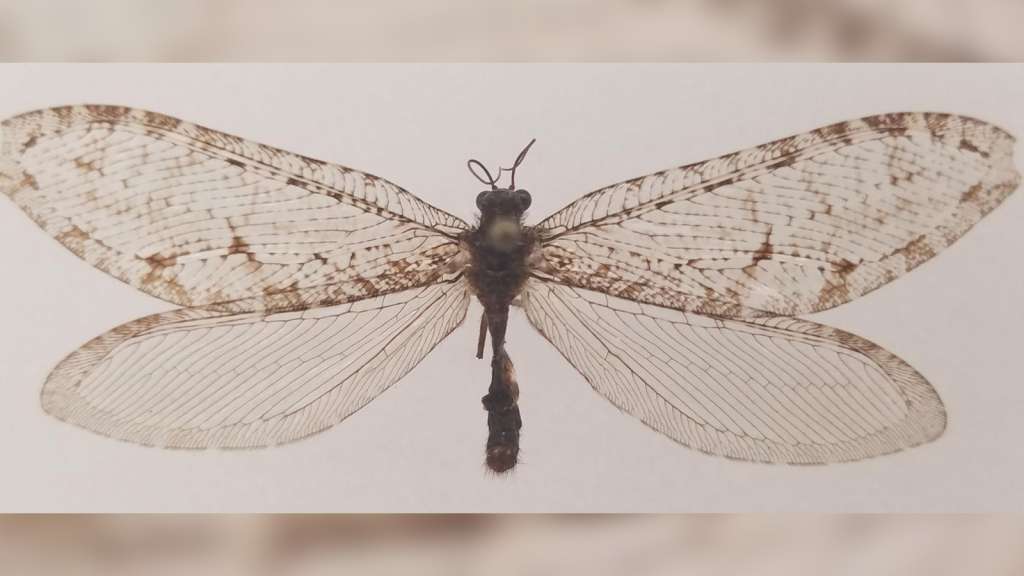(CNN) — An insect found on the side of a Fayetteville, Arkansas, big-box store has been identified as the species Polystoechotes punctata, which belongs to a family of insects that predates the dinosaurs.
Michael Skvarla, director of Pennsylvania State University’s Insect Identification Lab, spotted the Jurassic-era creature, otherwise known as a giant lacewing, on a shopping trip in 2012, when he was a doctoral student of entomology at the University of Arkansas.
“I remember it vividly, because I was walking into Walmart to get milk and I saw this huge insect on the side of the building,” Skvarla said in a statement. “I thought it looked interesting, so I put it in my hand and did the rest of my shopping with it between my fingers. I got home, mounted it, and promptly forgot about it for almost a decade.”
Skvarla initially had misidentified the lacewing as an antlion, a dragonfly-like insect that shares certain features, including long transparent wings, with the lacewing. But after presenting the insect to his online entomology course in the fall of 2020, he realized that what he had all those years was something much rarer and more impressive.
He performed further DNA analyses to confirm the identity of the insect, and the giant lacewing has now become part of the Frost Entomological Museum’s collection at Penn State.
The giant lacewing’s disappearance
The giant lacewing vanished in the 1950s from eastern North America, where it was formerly widespread, according to the paper Skvarla coauthored that was published in the Proceedings of the Entomological Society of Washington. Scientists thought the species had been completely wiped out in the region. The recent discovery of the lacewing in Arkansas is the first record of the species in the state.
“Entomology can function as a leading indicator for ecology,” Skvarla said in the statement. “The fact that this insect was spotted in a region that it hasn’t been seen in over half a century tells us something more broadly about the environment.”
While the mysterious disappearance of the insect is suspected to have been due to efforts to suppress natural forest fires in eastern North America, according to the paper, the bigger mystery is how the insect ended up at a superstore in an urban area of Arkansas.
“It could have been 100 years since (the species) was even in this area — and it’s been years since it’s been spotted anywhere near it. The next closest place that they’ve been found was 1,200 miles away, so very unlikely it would have traveled that far,” Skvarla said. He suggested the lacewing was attracted to the lights and flew at least a few hundred meters from where it had been living.
Skvarla’s find has opened the door for future lacewing discoveries, as insect enthusiasts begin to check their own collections and search for the species in the wild in places they hadn’t thought to look before, said Dr. Floyd Shockley, the collections manager for the department of entomology at the Smithsonian National Museum of Natural History.
“Anytime that you find an insect species not in a place that you’re used to it being, that has a lot of implications for our understanding of that species — the kind of distribution it has, the kind of ecosystem that it might require to complete its lifecycle,” Shockley said. “It means something that we thought was gone, at least from the Eastern US, may still be there, and it’s just hiding in small pockets.”
Shockley also noted the importance of museum collections, such as the one with the Smithsonian or at Penn State, where the lacewing resides, as they “help to capture different snapshots of biodiversity across time and allows us to see what is happening and why it is happening.”
“Everybody always sort of focuses in on the big stuff — big birds and mammals and things like that. But this is an insect world. … We’re just living on it,” Shockley said. “It is really important to have that sort of appreciation. And one of the nice things about insects is that there is so much diversity for you to appreciate, just in your backyard.”
(Copyright (c) 2024 CNN. All Rights Reserved. This material may not be published, broadcast, rewritten, or redistributed.)

